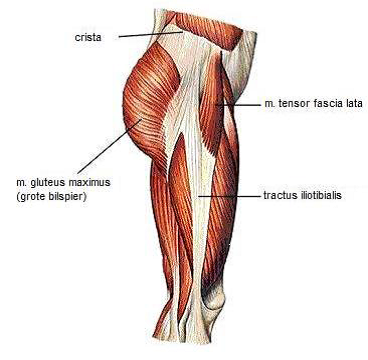Intrinsic:
- Position deviations in the legs (X- and O-legs) and hips as a result of which the legs are not straight under the pelvis
- Position deviations of the feet, such as arched feet, or flat feet with overpronation, so that too much walking is done on the inside of the foot and the knee rolls inwards
- Too short, tight iliotibial band
- Decreased strength of the buttock and thigh muscles. This mainly concerns the muscles that move the leg outwards. This makes landing control worse, allowing the knee to turn inward and the hip to tilt outward
Extrinsic:
- Worn or too stiff running shoes, as a result of which the cushioning is insufficient
- Corrective footwear that is too strong so that the foot is tilted outward too much
- Walking on a hard surface
- Making too many turns in the same direction (for example when walking around a field or cinder track), or walking too much on one side of a curved road
- Overload due to overtraining or a one-time extreme effort
Treatment
Correcting intrinsic and extrinsic factors is a first step. For example, measuring insoles, adjusting footwear and surface.
Exercise therapy:
This includes exercises that strengthen the gluteal and thigh muscles. Exercises should be performed once or twice a day, and need at least 6 weeks to provide relief.
Keeping ice on the most painful spot for at least 10 minutes after the exercises reduces blood flow and also reduces the inflammatory response.
Medicine:
In the acute phase, anti-inflammatory drugs (e.g. ibuprofen or diclofenac) can reduce the symptoms. The combination of anti-inflammatory and analgesic effect accelerates healing.
Corticosteroid injections:
A local corticosteroid injection inhibits the inflammatory response and thereby reduces pain for several weeks to months. If the cause is not addressed, the complaints will often return over time.
Operation:
An operation can be considered if a well-structured exercise program in combination with the medication still has no effect after 6-12 months. The affected portion of the iliotibial band sliding over the bone and the inflamed bursa are removed.
ITBS and sports
It is advised to choose an alternative form of training (eg swimming, skating or a strength program) to maintain fitness, strength and stability.
In addition, the sport that caused the complaints must be reduced (in duration and/or intensity) to a level at which the complaints are not aroused.
If there is a clear improvement in the complaint and causal factors have been addressed, you can start building up the sports load according to a progressive load schedule.
Prevention
The risk of iliotibial band syndrome can be reduced by paying attention to the following:
The most common cause is overload (training too much, too often and too hard). This is a pitfall, especially at the start of the season or when returning from an injury. A good training structure is important, whereby the scope of the training is first expanded (the number of hours) and only then the intensity (intensive forms of exercise with a lot of running work).
Due to its damping effect, forest soil is an ideal surface to walk on, especially when you are just starting to walk.
Participating in extreme sporting challenges gives a kick! However, don’t sell yourself short and make sure you start your sports preparation early enough. Being well trained at the start is essential to prevent injuries.
Choose sports shoes that are suitable for the personal running style and foot shape. Good advice from the specialist shop is very valuable here. The average life of a sports shoe is 500 to 750 kilometers. After this, it quickly loses its shock-absorbing effect.
Sometimes the body has certain shortcomings (think X and O legs) that can cause an injury. When these factors are recognized and corrected in time, unnecessary injuries are prevented.

